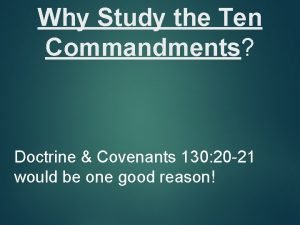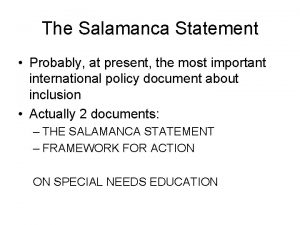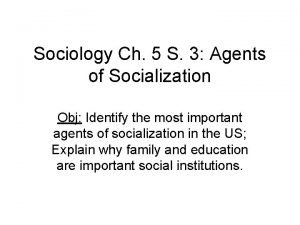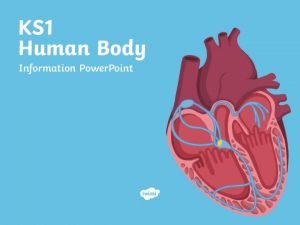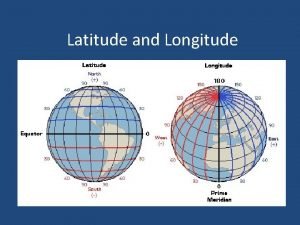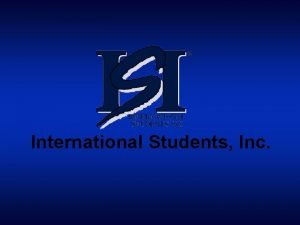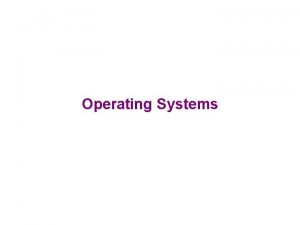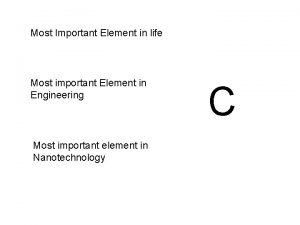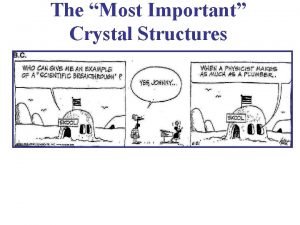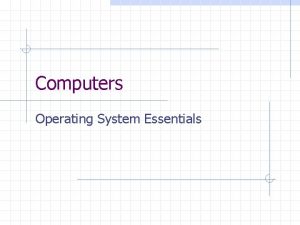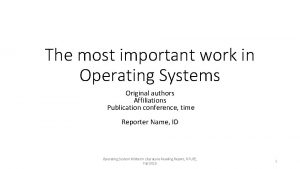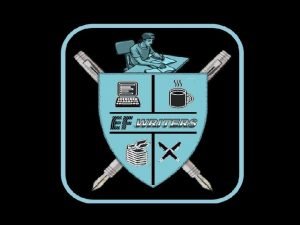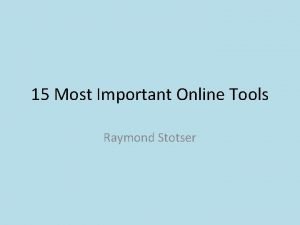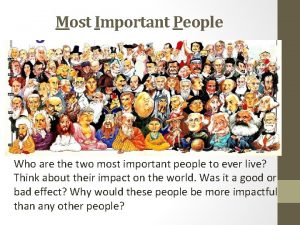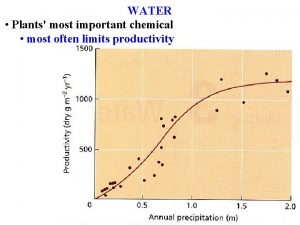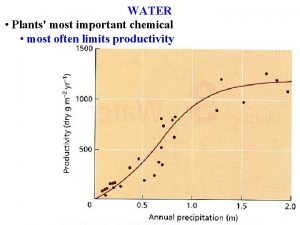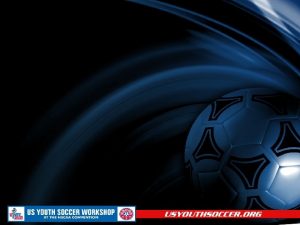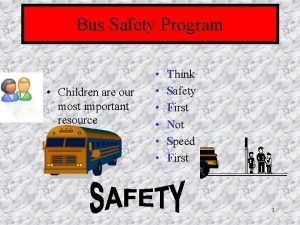Operating Systems Operating systems Most important program that





















- Slides: 21

Operating Systems

Operating systems ® ® Most important program that runs on a computer Every general-purpose (such as desktop) computer must have OS to run other programs Manages the hardware and software resources of the system Provides stable and consistent way for applications to deal with the hardware without having to know all the details Most common § Windows, UNIX, Macintosh Many other OS designed for special-purpose applications § mainframes, robotics, manufacturing, real-time control systems ® ®

Starting the computer BIOS loads the bootstrap loader (or bootstrap program) from a known location on disk and starts it ® Bootstrap loader looks for the OS kernel and loads it into memory ® The kernel initializes the hardware present in the system and loads required drivers ® OS begins loading services and application programs and shows the user interface ®

Managing hardware and software Various programs and input methods compete for the attention of the central processing unit (CPU) § programs and methods demand memory, storage and input/output (I/O) bandwidth for their own purposes ® OS makes sure each application gets the necessary resources while cooperating with the other applications § economizes capacity of the system to greatest benefit of users and applications. ®

Software OS Hardware

Providing consistent application interface Important if more than one type of computer is using OS or if computer hardware is open to change ® A consistent application program interface (API) allows software developer to write an application on one computer and have a high level of confidence that it will run on another computer of the same type § even if the amount of memory or the quantity of storage is different on the two machines ® OS can ensure that applications continue to run when hardware upgrades and updates occur § OS and not the application is charged with managing the hardware and the distribution of its resources ®

Tasks of the OS A task refers to the combination of a program being executed and bookkeeping information used by the operating system ® Tasks of the OS: § Processor management § Memory management § Device management § Storage management § Application interface § User interface ®

Processor management Ensuring that each process and application receives enough of the processor's time to function properly ® Using as many processor cycles for real work as is possible ® Processes (thread) § schedule work done by processor § CPU can only do one thing at a time § OS has to switch between different processes thousands of times a second § OS sets a certain number of CPU execution cycles to one program, after those cycles switches to another program, etc. ®

Memory and storage management Each process must have enough memory in which to execute, and it can neither run into the memory space of another process nor be run into by another process ® The different types of memory in the system must be used properly so that each process can run most effectively ® Memory types § High-speed cache - fast, small amounts of memory available to the CPU, where cache controllers predict which data CPU will need next and pull it from main memory § Main memory - RAM § Secondary memory - disk ®

Virtual memory The memory installed in a computer is called physical memory § limited in size and shared by all processes ® Virtual memory assigns a different address space to every process § address 5 for process 1 describes a different location in physical memory than address 5 for process 2 § prevents processes from accessing each others memory (memory protection) ® OS can allocate more space in virtual memory than is present in physical memory by using paging ®

Paging ® ® ® OS must balance the needs of the various processes with the availability of the different types of memory Not enough memory to run all processes simultaneously Processes not running take up space in memory Paging: allocating physical memory to processes in fixedsize blocks called pages Separate programs into pages and keep only a few pages of each running program in memory at one time § active pages kept in memory § inactive pages kept on disk, brought in as needed Moving pages in and out of memory is called swapping

Thrashing If user runs too many processes at the same time, OS will use majority of its available CPU cycles to swap between processes rather than run processes ® Paging or swapping systems that are overloaded waste most of their time moving data rather than performing useful computation ® Thrashing CPU utilization, system throughput and system response time decrease resulting poor performance of a system ® Risk of thrashing increases with degree of multiprogramming ®

Device management Device driver § path between the operating system and (most) hardware not on computer's motherboard § translator between signals of the hardware subsystems and high-level programming languages of the OS and application programs § takes file data from OS and translates into bit streams put in specific locations on storage devices ® Drivers are run when device is required, function basically like any other process ® OS assigns high-priority blocks to drivers so hardware resources can be released and readied for further use as quickly as possible ®

Application and user interfaces Application Program Interfaces (APIs) § allow application programmers to use functions of computer and OS without worrying about details of CPU operation § provides a consistent way for applications to use the resources of the computer system ® User Interface (UI) § brings structure to the interaction between a user and the computer § program or set of programs that sits as a layer above the OS § usually a graphical user interface (GUI) ®

Classification Multi-user § allows many different users to take advantage of the computer's resources simultaneously ® Single-user, multi-tasking § single user operates many programs at same time § most desktop and laptop computers today ® Single-user, single task § one user can do one thing at a time (e. g. Palm OS) ® Real time (RTOS) § particular operation executes in precisely the same amount of time every time it occurs § machinery, scientific instruments and industrial systems ®

Types of operating systems

Open Source Description of software distributed as source code under licenses that guarantee everyone the right to freely use, change, or redistribute the source code ® Initiated by Bruce Perens § primary author of The Open Source Definition, the formative document of Open Source movement ® The basic idea behind open source is very simple: When programmers can read, redistribute, and modify the source code for a piece of software, the software evolves. People improve it, people adapt it, people fix bugs. And this can happen at a speed that, if one is used to the slow pace of conventional software development, seems astonishing. www. opensource. org

Open Source definition ® Distribution terms of open-source software must comply with the following criteria: 1. free redistribution 2. source code 3. derived works 4. integrity of the author's source code 5. no discrimination against persons or groups 6. no discrimination against fields of endeavor 7. distribution of license 8. license must not be specific to a product 9. the license must not restrict other software 10. the license must be technology-neutral www. opensource. org

The GNU Project Founded by Richard Stallman ® Launched in 1984 to develop a complete free Unix- like operating system: GNU ® GNU Manifesto § written by Stallman at start of GNU Project to ask for participation and support ® GNU is free software § everyone is free to copy and redistribute it as well as make changes either large or small § www. gnu. org ®

Linux is a Unix-like kernel, created by Linus Torvalds in 1991 ® Linux together with the GNU operating system made a complete free system: a Linux-based version of the GNU system § GNU/Linux system ® GNU/Linux systems are in widespread use § estimated 20 million users ® Complete, free OS ®

References ® ® ® ® ® www. webopedia. com www. howstuffworks. com www. linux. org www. microsoft. com www. apple. com www. opensource. org www. stallman. org www. gnu. org www. perens. com FOLDOC
 Example of a news story
Example of a news story From most important to least important in writing
From most important to least important in writing Least important to most important
Least important to most important Phân độ lown ngoại tâm thu
Phân độ lown ngoại tâm thu Block xoang nhĩ độ 2 type 1
Block xoang nhĩ độ 2 type 1 Thơ thất ngôn tứ tuyệt đường luật
Thơ thất ngôn tứ tuyệt đường luật Thơ thất ngôn tứ tuyệt đường luật
Thơ thất ngôn tứ tuyệt đường luật Chiến lược kinh doanh quốc tế của walmart
Chiến lược kinh doanh quốc tế của walmart Tìm vết của đường thẳng
Tìm vết của đường thẳng Hãy nói thật ít để làm được nhiều
Hãy nói thật ít để làm được nhiều Tôn thất thuyết là ai
Tôn thất thuyết là ai Gây tê cơ vuông thắt lưng
Gây tê cơ vuông thắt lưng Sau thất bại ở hồ điển triệt
Sau thất bại ở hồ điển triệt Doctrine and covenants 130
Doctrine and covenants 130 Salamanca statement summary
Salamanca statement summary Most important agent of socialization
Most important agent of socialization Most important agent of socialization
Most important agent of socialization Different parts of body
Different parts of body Imaginary horizontal lines around the earth
Imaginary horizontal lines around the earth 2 most important commandments
2 most important commandments Most important thing in life essay
Most important thing in life essay List and describe two types of professional draping
List and describe two types of professional draping













